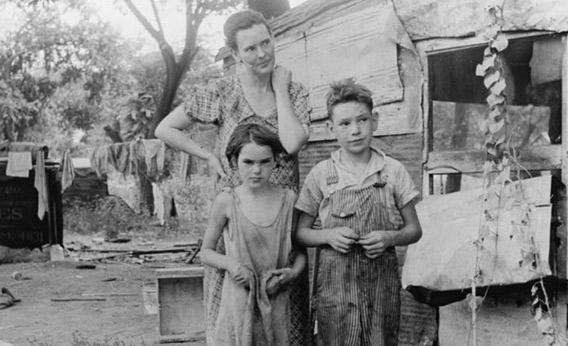 The official poverty line was created in 1963 by food and nutrition economist Mollie Orshansky and hasn?t been updated since
The official poverty line was created in 1963 by food and nutrition economist Mollie Orshansky and hasn?t been updated sincePhotograph by Dorothea Lange/Library of Congress.
?We declared war on poverty,? Ronald Reagan famously proclaimed, ?and poverty won.? And indeed, as measured by the official poverty rate, the United States seems to have made very little progress in curbing poverty. But important new research released this week by Bruce D. Meyer of the University of Chicago and James X. Sullivan of the University of Notre Dame indicates that the official measure is giving us an extremely misleading view. In fact, poverty fell substantially over the past several decades before rising a bit during the Great Recession.
Neither liberals nor conservatives have been eager to embrace this idea?the former to bolster support for new programs and the latter to dismiss the efficacy of what?s already been done. But as Meyer pointed out in a talk at the Brookings Institution on Thursday, the way the government measures poverty actually by definition excludes the possibility that public programs are lifting families out of poverty. The truth, when examined correctly, is that we?ve hit upon a very effective means of waging war on poverty?give money to poor people?and we could make even more progress by doing even more of it.
The official poverty line was created in 1963 by food and nutrition economist Mollie Orshansky and hasn?t been updated since.
Her method, though arguably appropriate at the time, is incredibly crude by modern standards. Her idea was to calculate the cost of a nutritionally adequate diet for a given-size family. Then she used the early-?60s rule of thumb that food was about one-third the typical family?s budget. So calculate the income needed to prevent malnutrition, triple it, and there?s your poverty line.?
Needless to say, this has only a hazy relationship with modern living standards. Worse, because at the time there were few government programs designed to help the poor, it refers to income before taxes and cash transfer payments. The formula also neglects to include the value of in-kind public services such as food stamps and Medicaid, and smaller programs like housing vouchers.
The problems with the poverty-line methodology are well known, but they are often thought to impact merely the level of poverty, rather than the change over time. Meyer and Sullivan challenge this assumption. They argue for starters that the standard inflation measure suffers from ?outlet bias.? It fails, in other words, to adequately account for the rise of cheaper big box stores?exactly the kind of development most likely to benefit the poor. Merely making this inflation adjustment paints a brighter picture of living standards at the low end.
They also show that public policy has made a big difference in the real poverty rate. Throughout the ?60s and ?70, the tax code was made friendlier to poor people. That was partially rolled back by Ronald Reagan in 1981, but then the 1986 tax reform changed the tide again by introducing the Earned Income Tax Credit. This important program?a form of wage subsidy for low-income families?pushed after-tax poverty down substantially in the early 1990s. The tax provisions of the 2009 stimulus bill, once again, made the after-tax situation of low-income households better looking than the official line?s pretax numbers would suggest. Social Security, especially through its disability insurance function, has also played a big role in pushing actual poverty between 1967 and 2010 down six percentage points more than the official stats say. Other cash transfers?unemployment Insurance, veterans? benefits, ?welfare,? workers? comp?aren?t as big a deal, but still make a difference to the tune of one percentage point. What?s more, these safety net programs also smoothen the business cycle. When you include them in the calculation, poverty doesn?t rise as much during recessions or fall as sharply during recoveries.
The authors also show that if you simply ignore income altogether and look at consumption?what people buy?things look even better. It?s not entirely clear why this would be. One theory is that people underreport government benefits they receive. Another is that they?re underreporting under-the-table income (perhaps to retain eligibility for benefits). Another factor is that consumption measures do a better job of capturing the existence of in-kind provision of social services?public housing, community health centers, and other efforts to give free or discounted goods to the poor. The demographics of poverty look different if you rely on consumption measures rather than income ones?fewer elderly poor and more poor members of married couple households.
Given the demographic split, it seems clear that better data are needed to understand which populations really face the most severe needs. But whether you look at it in terms of consumption or income, the news is good. The impact of the recession aside, we?re clearly winning the decades-long war on poverty. We?re doing so in part because the economy is evolving in ways that are favorable to the poor, and in part because our government programs are effective. In particular, the not-very-complicated strategy of giving money to the poor through tax credits and Social Security has steadily pushed the poverty rate down over decades, while safety net programs help shelter people from recessions. It?s understandable that advocates like to underscore the severity of social problems. But at a time when many voters seem skeptical about the efficacy of government programs it?s worth saying that these programs work. Long-term investment in anti-poverty spending has done exactly what it is supposed to do.
Source: http://feeds.slate.com/click.phdo?i=ffec27fd755241df48ee86f9e4fbf0e6
starship troopers cruise ship italy patriots broncos game saints willis mcgahee willis mcgahee ship aground off italy
No comments:
Post a Comment
Note: Only a member of this blog may post a comment.